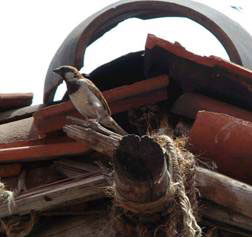By - Ragoo Rao
A proven hanger-on of man, whether in a busy urban locality, hilly area or the plains, this Ashy grey bird about six inches long was a very familiar bird until a decade and a half ago. It is inseparable from human habitation and hence
the Latin name-Passer domesticus.
 The males are slightly darker rufus colored around the head and wings, with a grayish patch below the beak. Females are ashy brown with streaks of black on the wings and upper body. These birds are omnivorous, eating grains and insects
alike with relish. Sometimes they come to the kitchen window sills also in search of grains or cooked rice. They literally stay around in compounds and roost in shrubs in the compounds. Their favourite plants for roosting being medium Pomegranate trees or
Bougainvillea.
The males are slightly darker rufus colored around the head and wings, with a grayish patch below the beak. Females are ashy brown with streaks of black on the wings and upper body. These birds are omnivorous, eating grains and insects
alike with relish. Sometimes they come to the kitchen window sills also in search of grains or cooked rice. They literally stay around in compounds and roost in shrubs in the compounds. Their favourite plants for roosting being medium Pomegranate trees or
Bougainvillea.
They create a noisy chirping in the twilight until the roosting order is settled. The males are easily heard with their characteristic- chi-chi-chi and chrrr-chrrr-chrrrr. The breeding males sing a loud monotonous tsi-tsi-tsi, with their
feathers ruffled up and hopping closer to the enticed female. Breeding season is practically year round. Their favourite nesting sites could be under the rafters in tiled houses, behind photo-frames hung inside the houses, a niche under the tiled roofs. The
nest is made up of feathers, dried grass, straw and rubbish. Three to five pale greenish eggs with brown blotches are laid in the nests. Both the parents share all domestic chores. The young hatchlings are exclusively raised on insect larvae and insects. Several
successive broods are raised in the same nest. One can see the fledglings, after they come out of the nests, still hanging on to their parents begging for food with a shrill chi-chi- chi-chi and pestering the parents.
Unfortunately, this once common bird is becoming a rare sight in urban localities owing to several reasons. All these reasons for their becoming rare are the contributions of Man.
The observations which I have made, in my opinion, can be summarized into these main factors:
• Loss of foraging grounds in urban areas.
• Loss of nesting sites.
• Loss of insect population to bring up a brood.
• Loss of roosting shrubs.
In effect, a total loss of habitat in urban areas.
The encouraging thing is one can still find the much loved House sparrow in the rural hamlets and also in the urban areas in isolated pockets where the environment is still congenial to them in their basic requirements.
(Photo of male sparrow near nest: Ragoo Rao)
A Field study of the House Sparrow.